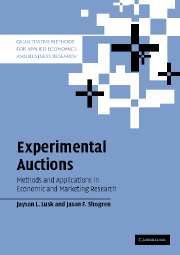Book contents
- Frontmatter
- Contents
- List of figures
- List of tables
- 1 Introduction
- 2 Incentive compatible auctions: theory and evidence
- 3 Value theory
- 4 Conducting experimental auctions: some preliminaries
- 5 Conducting experimental auctions
- 6 Data analysis
- 7 Valuation case studies
- 8 Auction design: case studies
- 9 Validity of experimental auctions
- 10 The future of experimental auctions
- References
- Index
6 - Data analysis
Published online by Cambridge University Press: 27 October 2009
- Frontmatter
- Contents
- List of figures
- List of tables
- 1 Introduction
- 2 Incentive compatible auctions: theory and evidence
- 3 Value theory
- 4 Conducting experimental auctions: some preliminaries
- 5 Conducting experimental auctions
- 6 Data analysis
- 7 Valuation case studies
- 8 Auction design: case studies
- 9 Validity of experimental auctions
- 10 The future of experimental auctions
- References
- Index
Summary
Introduction
We now examine several methods commonly used to examine bidding behavior in experimental auctions. We focus attention on econometric models and other techniques that have direct applicability for auction data and are likely to receive less coverage in introductory econometrics and statistical texts. The chapter does not cover elementary statistical analysis such as ANOVA and ordinary least squares regression since numerous sources already exist for interested readers (e.g., see Greene, 2000).
Censored regressions with auction bids
One strength of experimental auctions is that they provide continuous measures of individuals' valuations; one drawback is that these bids are often censored. Censoring occurs when bids are transformed to a single value when they exceed or fall below a particular threshold. A common form of censoring occurs in auctions where people are not permitted to bid below zero. Participants transform negative bids to $0.00. It is helpful to contrast censoring with truncation. Censored data are observed but their observed values take on restricted values, that is, $0.00. In contrast, if a dependent variable is truncated, observations will be unobserved in particular ranges.
To make concrete these ideas, consider a latent, unobserved variable y* that can take on any value on the real line, but where y is the variable actually observed. For example, y might represent observed auction bids censored from below at zero in auctions that do not permit negative bidding.
- Type
- Chapter
- Information
- Experimental AuctionsMethods and Applications in Economic and Marketing Research, pp. 95 - 112Publisher: Cambridge University PressPrint publication year: 2007

